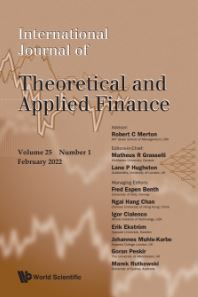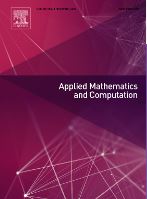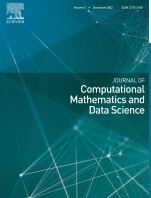
Accelerated computations of sensitivities for xVA, IJCM, 1-23, 2203277. Joint work with G. Deelstra and F.L. Wolf, 2023.
Abstract: Exposure simulations are fundamental to many xVA calculations and are a nested expectation problem where repeated portfolio valuations create a significant computational expense. Sensitivity calculations which require shocked and unshocked valuations in bump-and-revalue schemes exacerbate the computational load. A known reduction of the portfolio valuation cost is understood to be found in polynomial approximations, which we apply in this article to interest rate sensitivities of expected exposures. We consider a method based on the approximation of the shocked and unshocked valuation functions, as well as a novel approach in which the difference between these functions is approximated. Convergence results are shown, and we study the choice of interpolation nodes. Numerical experiments with interest rate derivatives are conducted to demonstrate the high accuracy and remarkable computational cost reduction. We further illustrate how the method can be extended to more general xVA models using the example of CVA with wrong-way risk.
To see the complete article click here and for pre-print click here.

Randomization of Short-Rate Models, Analytic Pricing and Flexibility in Controlling Implied Volatilities, 2023.
Abstract: We focus on extending existing short-rate models, enabling control of the generated implied volatility while preserving analyticity. We achieve this goal by applying the Randomized Affine Diffusion (RAnD) method to the class of short-rate processes under the Heath-Jarrow-Morton framework. Under arbitrage-free conditions, the model parameters can be exogenously stochastic, thus facilitating additional degrees of freedom that enhance the calibration procedure. We show that with the randomized short-rate models, the shapes of implied volatility can be controlled and significantly improve the quality of the model calibration, even for standard 1D variants. In particular, we illustrate that randomization applied to the Hull-White model leads to dynamics of the local volatility type, with the prices for standard volatility-sensitive derivatives explicitly available. The randomized Hull-White (rHW) model offers an almost perfect calibration fit to the swaption implied volatilities.
To read the pre-print please click here.

Efficient Wrong-Way Risk Modelling for Funding Valuation Adjustments, (Accepted, IJTAF), 2022. Joint work with T.vd. Zwaard and C.W. Oosterlee.
Abstract: Wrong-Way Risk (WWR) is an important component in Funding Valuation Adjustment (FVA) modelling. Yet, the standard assumption is independence between market risks and the counterparty defaults and funding costs. This typical industrial setting is our point of departure, where we aim to assess the impact of WWR without running a full Monte Carlo simulation with all credit and funding processes. We propose to split the exposure profile into two parts: an independent and a WWR-driven part. For the former, exposures can be re-used from the standard xVA calculation. We express the second part of the exposure profile in terms of the stochastic drivers and approximate these by a common Gaussian stochastic factor. Within the affine setting, the proposed approximation is generic, is an add-on to the existing xVA calculations and provides an efficient and robust way to include WWR in FVA modelling. Case studies for an interest rate swap and a representative multi-currency portfolio of swaps illustrate that the approximation method is applicable in a practical setting. We analyze the approximation error and use the approximation to compute WWR sensitivities, which are needed for risk management. The approach is equally applicable to other metrics such as Credit Valuation Adjustment.
To read the pre-print please click here. For the Journal version please click here.

On Randomization of Affine Diffusion Processes with Application to Pricing of Options on VIX and S\&P 500, (Submitted, 2022).
Abstract: The class of Affine (Jump) Diffusion (AD) has, due to its closed form characteristic function (ChF), gained tremendous popularity among practitioners and researchers. However, there is clear evidence that a linearity constraint is insufficient for precise and consistent option pricing. Any non-affine model must pass the strict requirement of quick calibration — which is often challenging. We focus here on Randomized AD (RAnD) models, i.e., we allow for exogenous stochasticity of the model parameters. Randomization of a pricing model occurs outside the affine model and, therefore, forms a generalization that relaxes the affinity constraints. The method is generic and can apply to any model parameter. It relies on the existence of moments of the so-called randomizer- a random variable for the stochastic parameter. The RAnD model allows flexibility while benefiting from fast calibration and well-established, large-step Monte Carlo simulation, often available for AD processes. The article will discuss theoretical and practical aspects of the RAnD method, like derivations of the corresponding ChF, simulation, and computations of sensitivities. We will also illustrate the advantages of the randomized stochastic volatility models in the consistent pricing of options on the S&P 500 and VIX.
To read the pre-print please click here.

Pricing and Hedging Prepayment Risk in a Mortgage Portfolio, IJTAF, 25(4-5), 2250016, 2022. Joint work with E. Casamassima, F.A. Mulder, and C.W. Oosterlee.
Abstract: Understanding mortgage prepayment is crucial for any financial institution providing mortgages, and it is important for hedging the risk resulting from such unexpected cash flows. Here, in the setting of a Dutch mortgage provider, we propose to include non-linear financial instruments in the hedge portfolio when dealing with mortgages with the option to prepay part of the notional early. Based on the assumption that there is a correlation between prepayment and the interest rates in the market, a model is proposed which is based on a specific refinancing incentive. The linear and non-linear risks are addressed by a set of tradeable instruments in a static hedge strategy. We will show that a stochastic model for the notional of a mortgage unveils non-linear risk embedded in a prepayment option. Based on a calibration of the refinancing incentive on a data set of more than thirty million observations, a functional form of the prepayments is defined, which accurately reflects the borrowers’ behaviour. We compare this functional form with a fully rational model, where the option to prepay is assumed to be exercised rationally.
To read the pre-print please click here. For the Journal version click here.

Sensitivities and Hedging of the Collateral Choice Option, IJTAF, 25(06), 2250027, 2022. Joint work with F.L. Wolf and G. Deelstraa.
Abstract: The collateral choice option allows a collateral-posting party the opportunity to change the type of security in which the collateral is deposited. Due to non-zero collateral basis spreads, this optionality significantly impacts asset valuation. Because of the complexity of valuing the option, many practitioners resort to deterministic assumptions on the collateral rates. In this article, we focus on a valuation model of the collateral choice option based on stochastic dynamics. Intrinsic differences in the resulting collateral choice option valuation and its implications for collateral management are presented. We obtain sensitivities of the collateral choice option price under both the deterministic and the stochastic model, and we show that the stochastic model attributes risks to all involved collateral currencies. Besides an inability to capture volatility effects, the deterministic model exhibits a digital structure in which only the cheapest-to-deliver currency influences the valuation at a given time. We further consider hedging an asset with the collateral choice option by a portfolio of domestic and foreign zero-coupon bonds that do not carry the collateral choice option. We propose static hedging strategies based on the crossing times of the deterministic model and based on variance-minimization under the stochastic model. We show how the weights of this model can be explicitly determined with the semi-analytical common factor approach and we show in numerical experiments that this strategy offers good hedging performance under minimized variance.
To read the pre-print please click here. For the Journal version click here.

Relevance of Wrong-Way Risk in Funding Valuation Adjustments, t Finance Research Letters, 103091, 2022. Joint work with T.vd. Zwaard and C.W. Oosterlee.
Abstract: In March 2020, the world was thrown into financial distress. This manifested itself in increased uncertainty in the financial markets. Many interest rates collapsed, and funding spreads surged significantly, which increased due to the market turmoil. In light of these events, it is essential to understand and model Wrong-Way Risk (WWR) in a Funding Valuation Adjustment (FVA) context. WWR may currently be absent from FVA calculations in banks’ Valuation Adjustment (xVA) engines. However, in this letter, we demonstrate that WWR effects are non-negligible in FVA modelling from a risk-management perspective. We look at the impact of various modelling choices, such as including the default times of the relevant parties, as well as stochastic and deterministic funding spreads. A case study is presented for interest rate derivatives.
To read the pre-print please click here. For the Journal version please click here.
Efficient Pricing and Calibration of High-Dimensional Basket Options, Submitted, 2022. Joint work with J. Jablecki and D. Gatarek.
Abstract: This paper studies equity basket options — i.e., multi-dimensional derivatives whose payoffs depend on the value of a weighted sum of the underlying stocks — and develops a new and innovative approach to ensure consistency between options on individual stocks and on the index comprising them. Specifically, we show how to resolve a well-known problem that when individual constituent distributions of an equity index are inferred from the single-stock option markets and combined in a multi-dimensional local/stochastic volatility model, the resulting basket option prices will not generate a skew matching that of the options on the equity index corresponding to the basket. To address this “insufficient skewness”, we proceed in two steps. First, we propose an “effective” local volatility model by mapping the general multi-dimensional basket onto a collection of marginal distributions. Second, we build a multivariate dependence structure between all the marginal distributions assuming a jump-diffusion model for the effective projection parameters, and show how to calibrate the basket to the index smile. Numerical tests and calibration exercises demonstrate an excellent fit for a basket of as many as 30 stocks with fast calculation time.
To read the pre-print please click here.
On Pricing of Discrete Asian and Lookback Options under the Heston Model, Submitted, 2022. Joint work with L. Perotti.
Abstract: We propose a new, data-driven approach for efficient pricing of – fixed- and float-strike – discrete arithmetic Asian and Lookback options when the underlying process is driven by the Heston model dynamics. The method proposed in this article constitutes an extension of our previous work, where the problem of sampling from time-integrated stochastic bridges was addressed. The model relies on the Seven-League scheme, where artificial neural networks are employed to “learn” the distribution of the random variable of interest utilizing stochastic collocation points. The method results in a robust procedure for Monte Carlo pricing. Furthermore, semi-analytic formulae for option pricing are provided in a simplified, yet general, framework. The model guarantees high accuracy and a reduction of the computational time up to thousands of times compared to classical Monte Carlo pricing schemes.
To read the pre-print please click here.
Sparse grid method for highly efficient computation of exposures for xVA, Applied Mathematics and Computation, 434, 127446, 2022.
Abstract: Every “x”-adjustment in the so-called xVA financial risk management framework relies on the computation of exposures. Considering thousands of Monte Carlo paths and tens of simulation steps, a financial portfolio needs to be evaluated numerous times during the lifetime of the underlying assets. This is the bottleneck of every simulation of xVA. In this article, we explore numerical techniques for improving the simulation of exposures. We aim to decimate the number of portfolio evaluations, particularly for large portfolios involving multiple, correlated risk factors. The usage of the Stochastic Collocation (SC) method, together with Smolyak’s sparse grid extension, allows for a significant reduction in the number of portfolio evaluations, even when dealing with many risk factors. The proposed model can be easily applied to any portfolio and size. We report that for a realistic portfolio comprising linear and non-linear derivatives, the expected reduction in the portfolio evaluations may exceed 6000 times, depending on the dimensionality and the required accuracy. We give illustrative examples and examine the method with realistic multi-currency portfolios consisting of interest rate swaps and swaptions.
To read the pre-print please click here. For the journal version click here.
Fast sampling from time-integrated bridges using deep learning, Journal of Computational Mathematics and Data Science, 5, 100060, 2022. Joint work with L. Perotti.
Abstract: We propose a methodology to sample from time-integrated stochastic bridges, namely random variables defined as ∫t2t1f(Y(t))dt conditioned on Y(t1)=a and Y(t2)=b, with a,b∈R. The Stochastic Collocation Monte Carlo sampler and the Seven-League scheme are applied for this purpose. Notably, the distribution of the time-integrated bridge is approximated utilizing a polynomial chaos expansion built on a suitable set of stochastic collocation points. Furthermore, artificial neural networks are employed to learn the collocation points. The result is a robust, data-driven procedure for the Monte Carlo sampling from conditional time-integrated processes, which guarantees high accuracy and generates thousands of samples in milliseconds. Applications, with a focus on finance, are presented here as well.
To read the pre-print please click here. For the journal version click here.

